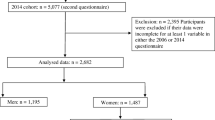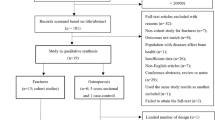Abstract
The study investigates the association of coffee consumption and odds of osteoporosis/osteopenia among individuals older than 50 years in the United States. In NHANES 2005–2014, drinking ≤ 2 cups(16 oz) of coffee per day can reduce the risk of osteoporosis/osteopenia at the femoral neck and lumbar spine in US adults. Previous epidemiological studies revealed that daily coffee intake reduced the incidence of a cluster of metabolic diseases, however, the link between coffee consumption and prevalence of osteoporosis/osteopenia still remain inconclusive and awaits further confirmation. Based on data collection from 2005 to 2014 survey cycles, National Health and Nutrition Examination Survey (NHANES), a sample size of 8789 participants aged 50 and above completing two nonconsecutive 24-h dietary recalls were eventually enrolled for analysis. Associations between coffee intake and BMD were assessed. A lower odds of having femoral neck osteopenia/osteoporosis (FOO) was observed in participants with moderate intake of coffee (≤ 2 cups per day), rather than other beverages (OR 0.83; 95% CI, 0.72–0.95; p = 0.01). Moreover, significant associations existed between daily caffeine intake and both FOO and lumbar-spine osteopenia/osteoporosis (LOO). Even after adjusting for decaffeinated coffee, tea, sugar-sweetened beverages (SSBs), and coffee consumption, osteopenia and osteoporosis the odds remained lower at both femoral and neck levels. Our data suggest moderate habitual coffee intake (≤ 2 cups coffee/day) would have protective effects against osteoporosis/osteopenia of femoral neck and spine, among US adults over the age of 50.
Similar content being viewed by others
Abbreviations
- AMPM:
-
USDA Computerized Automated Multiple Pass Method
- BMD:
-
Bone mineral density
- BMI:
-
Body mass index
- CDC:
-
Centers for Disease Control and Prevention
- CVD:
-
Cardiovascular diseases
- DGAC:
-
Dietary Guidelines for Americans
- DHHS:
-
Department of Health and Human Services
- DXA:
-
Dual-energy X-ray absorptiometry
- eBMD:
-
BMD estimated
- FNDDS:
-
Food and Nutrient Database for Dietary Studies
- FOO:
-
Femoral-neck osteopenia/osteoporosis
- GPAQ:
-
Global Physical Activity Questionnaire
- LOO:
-
Lumbar-spine osteopenia/osteoporosis
- MEC:
-
Mobile examination center
- MET:
-
Metabolic equivalent
- HANES:
-
National Health and Nutrition Examination Survey
- NCHS:
-
National Center for Health Statistics
- PD:
-
Parkinson disease
- PIR:
-
Poverty income ratio
- PSU:
-
Primary sampling unit; quantitative ultrasound
- SD:
-
Standard deviations
- SSBs:
-
Sugar-sweetened beverages
References
Kanis JA, Melton LJ 3rd, Christiansen C, Johnston CC, Khaltaev N (1994) The diagnosis of osteoporosis. J Bone Miner Res 9:1137–1141. https://doi.org/10.1002/jbmr.5650090802
Cummings SR, Melton LJ (2002) Epidemiology and outcomes of osteoporotic fractures. Lancet 359:1761–1767. https://doi.org/10.1016/S0140-6736(02)08657-9
Harvey N, Dennison E, Cooper C (2010) Osteoporosis: impact on health and economics. Nat Rev Rheumatol 6:99–105. https://doi.org/10.1038/nrrheum.2009.260
Compston JE, McClung MR, Leslie WD (2019) Osteoporosis. Lancet 393:364–376. https://doi.org/10.1016/S0140-6736(18)32112-3
Johnell O, Kanis JA (2006) An estimate of the worldwide prevalence and disability associated with osteoporotic fractures. Osteoporos Int 17:1726–1733. https://doi.org/10.1007/s00198-006-0172-4
Wright NC, Looker AC, Saag KG, Curtis JR, Delzell ES, Randall S, Dawson-Hughes B (2014) The recent prevalence of osteoporosis and low bone mass in the United States based on bone mineral density at the femoral neck or lumbar spine. J Bone Miner Res 29:2520–2526. https://doi.org/10.1002/jbmr.2269
Setchell KD, Lydeking-Olsen E (2003) Dietary phytoestrogens and their effect on bone: evidence from in vitro and in vivo, human observational, and dietary intervention studies. Am J Clin Nutr 78:593S-609S. https://doi.org/10.1093/ajcn/78.3.593S
Gonzalez de Mejia E, Ramirez-Mares MV (2014) Impact of caffeine and coffee on our health. Trends Endocrinol Metab 25:489–492. https://doi.org/10.1016/j.tem.2014.07.003
Butt MS, Sultan MT (2011) Coffee and its consumption: benefits and risks. Crit Rev Food Sci Nutr 51:363–373. https://doi.org/10.1080/10408390903586412
Loftfield E, Freedman ND, Dodd KW, Vogtmann E, Xiao Q, Sinha R, Graubard BI (2016) Coffee drinking is widespread in the united states, but usual intake varies by key demographic and lifestyle factors. J Nutr 146:1762–1768. https://doi.org/10.3945/jn.116.233940
Abalo R (2021) Coffee and caffeine consumption for human health. Nutrients 13:2918. https://doi.org/10.3390/nu13092918
Ding M, Bhupathiraju SN, Chen M, van Dam RM, Hu FB (2014) Caffeinated and decaffeinated coffee consumption and risk of type 2 diabetes: a systematic review and a dose-response meta-analysis. Diabetes Care 37:569–586. https://doi.org/10.2337/dc13-1203
Ding M, Satija A, Bhupathiraju SN, Hu Y, Sun Q, Han J, Lopez-Garcia E, Willett W, van Dam RM, Hu FB (2015) Association of coffee consumption with total and cause-specific mortality in 3 large prospective cohorts. Circulation 132:2305–2315. https://doi.org/10.1161/CIRCULATIONAHA.115.017341
Setiawan VW, Wilkens LR, Lu SC, Hernandez BY, Le Marchand L, Henderson BE (2015) Association of coffee intake with reduced incidence of liver cancer and death from chronic liver disease in the US multiethnic cohort. Gastroenterology 148:118-e15. https://doi.org/10.1053/j.gastro.2014.10.005
Niezen S, Mehta M, Jiang ZG, Tapper EB (2021) Coffee consumption is associated with lower liver stiffness: a nationally representative study. Clin Gastroenterol Hepatol S1542–3565(21):01057–40. https://doi.org/10.1016/j.cgh.2021.09.042
Santos C, Lunet N, Azevedo A, de Mendonça A, Ritchie K, Barros H (2010) Caffeine intake is associated with a lower risk of cognitive decline: a cohort study from Portugal. J Alzheimers Dis 20(Suppl 1):S175–S185. https://doi.org/10.3233/JAD-2010-091303
Grosso G, Micek A, Castellano S, Pajak A, Galvano F (2016) Coffee, tea, caffeine and risk of depression: a systematic review and dose-response meta-analysis of observational studies. Mol Nutr Food Res 60:223–234. https://doi.org/10.1002/mnfr.201500620
Hashibe M, Galeone C, Buys SS, Gren L, Boffetta P, Zhang ZF, La Vecchia C (2015) Coffee, tea, caffeine intake, and the risk of cancer in the PLCO cohort. Br J Cancer 113:809–816. https://doi.org/10.1038/bjc.2015.276
Caini S, Cattaruzza MS, Bendinelli B, Tosti G, Masala G, Gnagnarella P, Assedi M, Stanganelli I, Palli D, Gandini S (2017) Coffee, tea and caffeine intake and the risk of non-melanoma skin cancer: a review of the literature and meta-analysis. Eur J Nutr 56:1–12. https://doi.org/10.1007/s00394-016-1253-1256
Millen BE, Abrams S, Adams-Campbell L, Anderson CA, Brenna JT, Campbell WW, Clinton S, Hu F, Nelson M, Neuhouser ML, Perez-Escamilla R, Siega-Riz AM, Story M, Lichtenstein AH (2016) The 2015 dietary guidelines advisory committee scientific report: development and major conclusions. Adv Nutr 7:438–444. https://doi.org/10.3945/an.116.012120
Bycroft C, Freeman C, Petkova D, Band G, Elliott LT, Sharp K, Motyer A, Vukcevic D, Delaneau O, O’Connell J, Cortes A, Welsh S, Young A, Effingham M, McVean G, Leslie S, Allen N, Donnelly P, Marchini J (2018) The UK Biobank resource with deep phenotyping and genomic data. Nature 562:203–209. https://doi.org/10.1038/s41586-018-0579-z
Lips P (1997) Epidemiology and predictors of fractures associated with osteoporosis. Am J Med 103:3S-11S. https://doi.org/10.1016/s0002-9343(97)90021-8
Heaney RP, Recker RR (1982) Effects of nitrogen, phosphorus, and caffeine on calcium balance in women. J Lab Clin Med 99:46–55
Chau YP, Au PCM, Li GHY, Sing CW, Cheng VKF, Tan KCB, Kung AWC, Cheung CL (2020) Serum metabolome of coffee consumption and its association with bone mineral density: The Hong Kong osteoporosis study. J Clin Endocrinol Metab 105:dgz210. https://doi.org/10.1210/clinem/dgz210
Hallström H, Byberg L, Glynn A, Lemming EW, Wolk A, Michaëlsson K (2013) Long-term coffee consumption in relation to fracture risk and bone mineral density in women. Am J Epidemiol 178:898–909. https://doi.org/10.1093/aje/kwt062
Poole R, Kennedy OJ, Roderick P, Fallowfield JA, Hayes PC, Parkes J (2017) Coffee consumption and health: umbrella review of meta-analyses of multiple health outcomes. BMJ 359:j5024. https://doi.org/10.1136/bmj.j5024
Centres for Disease Control and Prevention (CDC) (2013) National Health and Nutrition Examination Survey Questionnaire Protocol. US Department of Health and Human Services. Hyattsville
Du Y, Liu B, Sun Y, Snetselaar LG, Wallace RB, Bao W (2019) Trends in adherence to the physical activity guidelines for Americans for aerobic activity and time spent on sedentary behavior among us adults, 2007 to 2016. JAMA Netw Open 2:e197597. https://doi.org/10.1001/jamanetworkopen.2019.7597
Johnson CL, Paulose-Ram R, Ogden CL, Carroll MD, Kruszon-Moran D, Dohrmann SM, Curtin LR (2013) National health and nutrition examination survey: analytic guidelines, 1999–2010. Vital Health Stat 2(161):1–24
Centers for Disease Control and Prevention. 1999–2006 DXA multiple imputation data files. Atlanta
Kanis JA, McCloskey EV, Johansson H, Oden A, Melton LJ 3rd, Khaltaev N (2008) A reference standard for the description of osteoporosis. Bone 42:467–475. https://doi.org/10.1001/jamanetworkopen.2019.7597
Marshall D, Johnell O, Wedel H (1996) Meta-analysis of how well measures of bone mineral density predict occurrence of osteoporotic fractures. BMJ 312:1254–1259. https://doi.org/10.1136/bmj.312.7041.1254
Kanis JA. Assessment of fracture risk and its application to screening for postmenopausal osteoporosis: synopsis of a WHO report (1994) WHO Study Group. Osteoporos Int 4:368–381. https://doi.org/10.1007/BF01622200
Looker AC, Johnston CC Jr, Wahner HW, Dunn WL, Calvo MS, Harris TB, Heyse SP, Lindsay RL (1995) Prevalence of low femoral bone density in older US women from NHANES III. J Bone Miner Res 10:796–802. https://doi.org/10.1002/jbmr.5650100517
Looker AC, Borrud LG, Hughes JP, Fan B, Shepherd JA, Melton LJ 3rd (2012) Lumbar spine and proximal femur bone mineral density, bone mineral content, and bone area: United States, 2005–2008. Vital Health Stat 11:1–132
US Department of Agriculture. The USDA Food and Nutrient Database for Dietary Studies, 2.0-Documentation and User Guide. Agricultural Research Service, Food Surveys Research Group; Beltsville, MD, USA: 2006. Available online: https://www.ars.usda.gov/ARSUserFiles/80400530/pdf/fndds/fndds2_doc.pdf.
Ahn H, Park YK (2021) Sugar-sweetened beverage consumption and bone health: a systematic review and meta-analysis. Nutr J 20:41. https://doi.org/10.1186/s12937-021-00698-1
Yuan S, Michaëlsson K, Wan Z, Larsson SC (2019) Associations of smoking and alcohol and coffee intake with fracture and bone mineral density: a mendelian randomization study. Calcif Tissue Int 105:582–588. https://doi.org/10.1007/s00223-019-00606-0
Chang HC, Hsieh CF, Lin YC, Tantoh DM, Ko PC, Kung YY, Wang MC, Hsu SY, Liaw YC, Liaw YP (2018) Does coffee drinking have beneficial effects on bone health of Taiwanese adults? A longitudinal study. BMC Public Health 18:1273. https://doi.org/10.1186/s12889-018-6168-0
Yang P, Zhang XZ, Zhang K, Tang Z (2015) Associations between frequency of coffee consumption and osteoporosis in Chinese postmenopausal women. Int J Clin Exp Med 8:15958–15966
Acknowledgements
We are thankful to all of the research participants and their partners for their invaluable assistance.
Funding
No funds or grants was received during this study.
Author information
Authors and Affiliations
Contributions
Conceptualization, TZ; literature research, JX; statistical analysis, JX; raw study data interpretation, TZ and JX; original draft preparation, JX; review and revision, TZ. Both JX and TZ approved of the final manuscript, and were responsible for the final decision to approve it for publication.
Corresponding author
Ethics declarations
Conflict of interest
JX and TZ declare they have no competing interest in relation to this study.
Human and Animal Rights
All procedures performed in studies involving human participants were in accordance with the ethical standards of the institutional and/or national research committee and with the 1964 Helsinki declaration and its later amendments or comparable ethical standards.
Informed Consent
All subjects provided written informed consent in line with the CDC.
Additional information
Publisher's Note
Springer Nature remains neutral with regard to jurisdictional claims in published maps and institutional affiliations.
Supplementary Information
Below is the link to the electronic supplementary material.
Rights and permissions
Springer Nature or its licensor (e.g. a society or other partner) holds exclusive rights to this article under a publishing agreement with the author(s) or other rightsholder(s); author self-archiving of the accepted manuscript version of this article is solely governed by the terms of such publishing agreement and applicable law.
About this article
Cite this article
Xu, J., Zhai, T. Coffee Drinking and the Odds of Osteopenia and Osteoporosis in Middle-Aged and Older Americans: A Cross-Sectional Study in NHANES 2005–2014. Calcif Tissue Int 114, 348–359 (2024). https://doi.org/10.1007/s00223-024-01184-6
Received:
Accepted:
Published:
Issue Date:
DOI: https://doi.org/10.1007/s00223-024-01184-6




